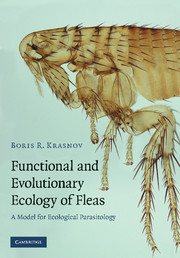Book contents
- Frontmatter
- Contents
- Preface
- Part I Brief descriptive ecology: what do fleas do?
- Part II Functional ecology: how do fleas do what they do?
- Part III Evolutionary ecology: why do fleas do what they do?
- 14 Ecology and evolution of host specificity
- 15 Ecology of flea populations
- 16 Ecology of flea communities
- 17 Patterns of flea diversity
- 18 Fleas, hosts, habitats
- 19 What further efforts are needed?
- References
- Index
19 - What further efforts are needed?
Published online by Cambridge University Press: 14 August 2009
- Frontmatter
- Contents
- Preface
- Part I Brief descriptive ecology: what do fleas do?
- Part II Functional ecology: how do fleas do what they do?
- Part III Evolutionary ecology: why do fleas do what they do?
- 14 Ecology and evolution of host specificity
- 15 Ecology of flea populations
- 16 Ecology of flea communities
- 17 Patterns of flea diversity
- 18 Fleas, hosts, habitats
- 19 What further efforts are needed?
- References
- Index
Summary
It is not accidental that the title of this book emphasizes functional and evolutionary aspects of flea ecology. It is also not accidental that Part I which focuses on the descriptive ecology of fleas is much shorter than either Part II or Part III. This is because we know much about the taxonomy, geographical distribution and biology of fleas. The level of our knowledge about fleas can be easily envisaged by looking at bibliographic databases. For example, Robert E. Lewis of Indiana State University compiled lists of papers and books that mentioned fleas in one way or another (although it not always is obvious from the titles) and presented them in the biannual newsletter Flea News at the website http://www.ent.iastate.edu/fleanews/ (there were 60 issues in total, the last one in July 2000). The list of publications on fleas from 1993 to 1997 contains 974 citations. In other words, the average number of publications on fleas per year from 1993 to 1997 was about 184. This is not much lower than the 230 publications per year in the period from 1969 to 1978 listed by F. G. A. M. Smit (Marshall, 1981a). The number of publications on fleas to the end of the 1970s was estimated at 11,000 (Marshall 1981a). Consequently, if we assume an average of 200 publications per year, there should be 16,000 publications at present! Moreover, this number is obviously an underestimation as it does not takes into account numerous papers in Russian and Chinese published in various collective monographs and proceedings of research institutes, plague-control stations and nature reserves.
- Type
- Chapter
- Information
- Functional and Evolutionary Ecology of FleasA Model for Ecological Parasitology, pp. 455 - 465Publisher: Cambridge University PressPrint publication year: 2008



